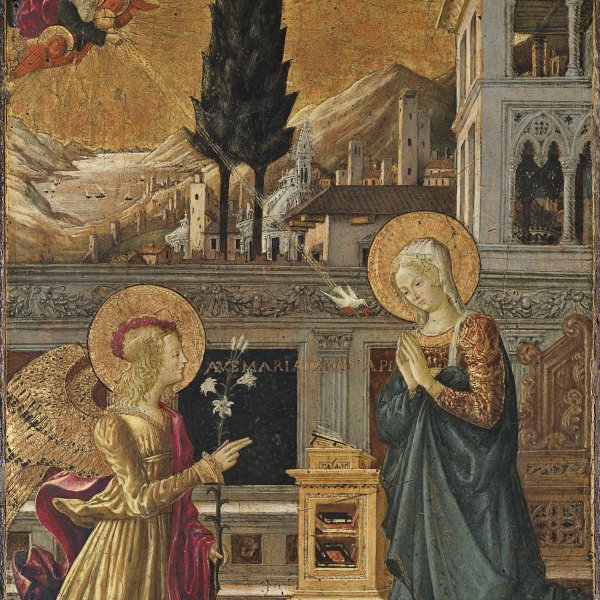Benedetto Bonfigli
Perugia, ca. 1420-1496
Benedetto Bonfigli was born in Perugia around 1420. The name of his teacher is not known but it is generally considered that he trained in his native city in an artistic ambience in which the late Gothic prevailed. According to Vasari, Bonfigli was the most highly esteemed painter in his region up to the time of Perugino. His work reveals the influence of Fra Angelico and Domenico Veneziano, particularly in his early works, while the style of Filippo Lippi subsequently interested him. It has been suggested that he made a trip to Florence and other Italian cities, studying and absorbing the style of Mantegna and of Netherlandish painting, influences that are evident in his late works. The first documented reference to Bonfigli’s activities dates from 1445, the date when he was commissioned to paint a Virgin and two angels for the chapel for the church of San Pietro in Perugia (now lost). A year later he was summoned by Pope Nicholas V to decorate various rooms in the Vatican, confirming his elevated reputation as an artist. Dating from this period are The Adoration of the Magi(Galleria Nazionale dell’Umbria, Perugia) and The Annunciation (Museo Thyssen-Bornemisza, Madrid).
A key date in Bonfigli’s career is that of 1454 when he received the important commission to execute frescoes for the chapel in the Palazzo dei Priori. Although now in a poor state of conservation, these are Bonfigli’s most ambitious works. Among the scenes in that cycle are The Crucifixion with Saints Francis and Herculano, and episodes from the life of Saint Louis of Toulouse. The latter scene reveals the influence of Piero della Francesca in various details and in the depiction of the cities of Rome and Perugia. From 1465 onwards Bonfigli devoted his activities to producing banners or gonfaloni, typical of the city of Perugia. These were generally painted on canvas and were used by the city’s confraternities, including that of the Virgin della Misericordia in San Francesco al Prato. In the 1460s Perugian art assumed a new direction with the arrival of Andrea del Verrocchio, Pollaiuolo and artists from Urbino, and while Bonfigli lived until 1496 he was never able to absorb and incorporate their innovations.
A key date in Bonfigli’s career is that of 1454 when he received the important commission to execute frescoes for the chapel in the Palazzo dei Priori. Although now in a poor state of conservation, these are Bonfigli’s most ambitious works. Among the scenes in that cycle are The Crucifixion with Saints Francis and Herculano, and episodes from the life of Saint Louis of Toulouse. The latter scene reveals the influence of Piero della Francesca in various details and in the depiction of the cities of Rome and Perugia. From 1465 onwards Bonfigli devoted his activities to producing banners or gonfaloni, typical of the city of Perugia. These were generally painted on canvas and were used by the city’s confraternities, including that of the Virgin della Misericordia in San Francesco al Prato. In the 1460s Perugian art assumed a new direction with the arrival of Andrea del Verrocchio, Pollaiuolo and artists from Urbino, and while Bonfigli lived until 1496 he was never able to absorb and incorporate their innovations.





